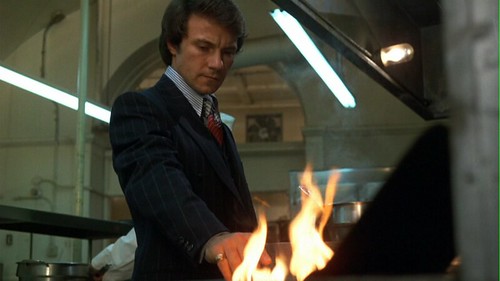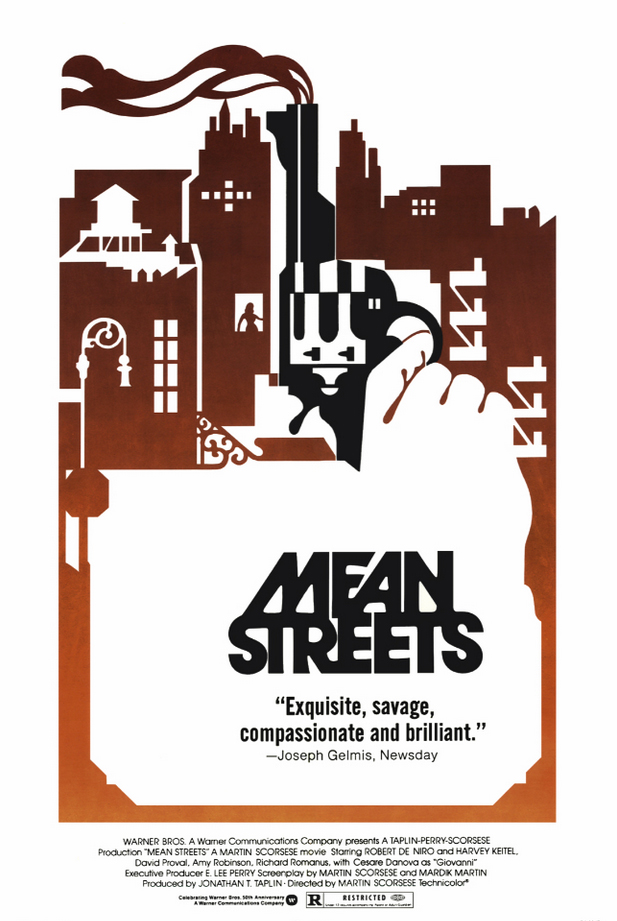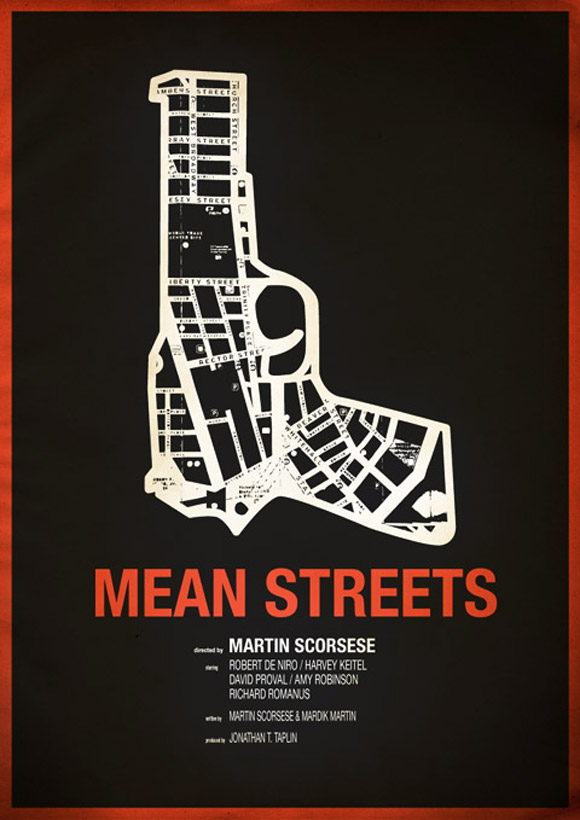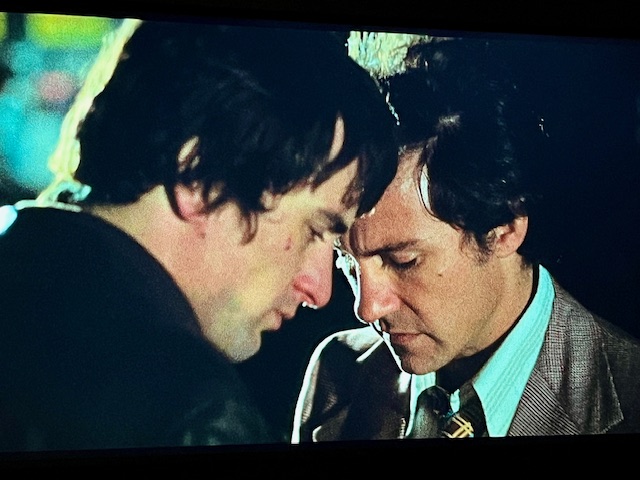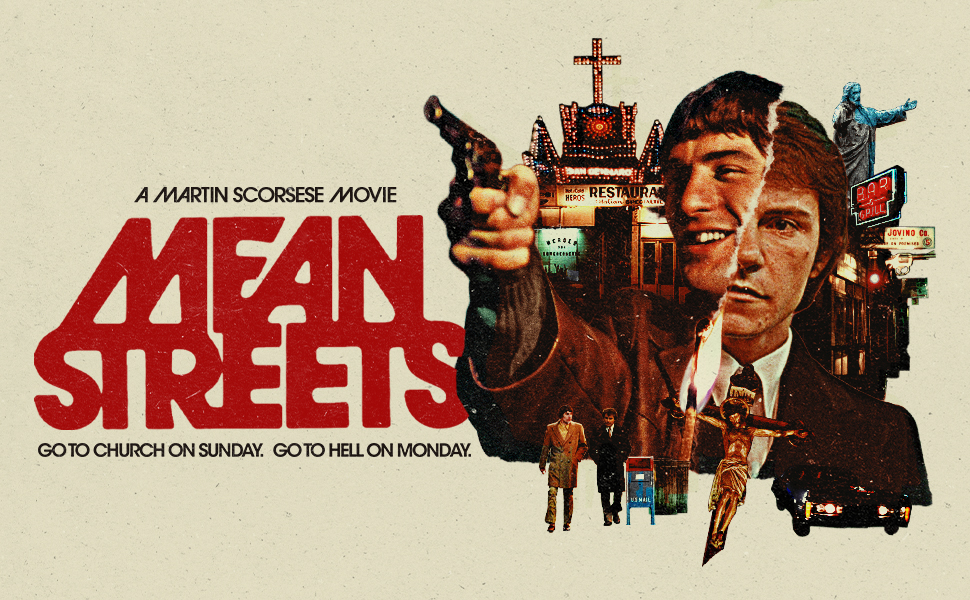
“Don’t you have something you really want to do?”
Eternal props to John Cassavetes, mentor not only to Martin Scorsese, but innumerable other apprentices who carried his torch and elevated American independent movies as a cultural force to be reckoned with. After seeing the abomination called Boxcar Bertha (Scorsese’s second film, from 1972), JC pulled Scorsese aside and said, equal parts big brother and fixer, “you just spent a year of your life making junk.”
As it happens, the younger artist did have something he really wanted to do. Duly chasted, and inspired, Scorsese reached deep into history (his own, and the rich history of cinema, with a special nod to Fellini’s I Vitelloni, from 1953) and recruited fellow NYU film student Mardik Martin to work on an autobiographical screenplay with the working title Season of the Witch. (Fortunately, the final product recalls Raymond Chandler instead of Donovan.)
The rest, of course, is history, but as is often the case, there was pre-history before History got made. Indeed, even as everything about Mean Streets seems like lightning in a bottle, Scorsese had labored for a decade as an apprentice: ambitious, opportunistic, immature, not yet ready for Prime Time. There’s an eternal lesson here for aspiring creatives: seldom, if ever, does an artist get shot from a cannon fully baked (and those that do are not often around for the long haul). Who’s That Knocking at My Door, Scorsese’s first film (’67) proved to be a test run, the rough draft that needed more time, a much better screenplay, the right music, and a generous dash of originality. By the time Mean Streets hit the big screen, Scorsese was locked and loaded, and this labor of tough love set the tone for a career that never really slowed down.
Let’s contemplate 1973 and another seminal American icon who introduced himself to the world: Bruce Springsteen. You listen to the one-two punch of Greetings from Asbury Park, N.J. and The Wild, The Innocent, & The E-Street Shuffle and hear an artist throwing everything he’s seen, done, heard about, and wants to immortalize into sprawling, deeply personal efforts. There was more (and, arguably, much better) to come from both men, but while Springsteen’s opening salvos and Mean Streets hold up wonderfully as standalone achievements, they also serve as obvious blueprints for bodies of work that simultaneously carve out and burrow deeply into felt spaces. Two artists who could theoretically see one another from across the river, but entire continents apart personally, aesthetically, and otherwise, making it their calling cards to evoke and celebrate the places that made them.
Understanding American Graffiti came out the same year, did spectacularly well, and was/is considered influential while Mean Streets did well critically but not commercially offers several lessons about art and what endures. It makes little sense on some levels, until you consider that American Graffiti spawned Happy Days while Mean Streets spawned The Sopranos.
Lights, camera, action: best opening credits sequence ever; the movie inside a movie (better still, the home movie about a home movie based on a home movie) was not even close to a cliché yet—a discerning fan’s kind of meta, and one of the many things Scorsese may not have invented, but certainly perfected if not patented. And after that proto-documentary sequence, our first image is the aerial view of a church while we pan over Little Italy: the Feast of San Gennaro. And then? A close-up of a junkie shooting up in a dirty bathroom stall. There it is, the entire Scorsese aesthetic in less than thirty seconds. From the voiceover narration as Charlie looks at himself in the mirror to “Be My Baby,” to these two sequences. This is how you make an entrance, and no one has executed a better one before or since.
Charlie (Harvey Keitel doing career-best work) contemplating the pain of hell while holding his finger over a flame (“you don’t fuck around with the infinite”) is not only what we could call quintessential Scorsese, but a window into a world that was already receding, post-Vatican II. These Italian Catholics (like the Irish Catholics they fought with and alongside on street corners and in picket lines) came from a generation that still believed in a literal hell, and that there was no shortage of ways we could damn our souls to eternal misery. It’s an inextricable part of Charlie’s character—and turmoil—but more like a chronic condition he wrestles with and less a round-the-clock way of life (one of the ways he and his ilk lived in a kinder, gentler world, existentially speaking, than their parents). Understanding this and knowing it’s the same headspace Scorsese was coming from (and struggled with, as man and artist) informs a deeper appreciation of everything that followed, from Taxi Driver and Raging Bull to The Last Temptation of Christ and Silence.
Most authentic New York City film of the decade? Possibly.
Estimated time of footage actually shot in NYC? Six minutes.
That’s courtesy of cinematographer Kent Wakefield, and it might take even the most ardent Scorsese aficionados some time to process this. Due to resources and budget, getting the film done the way Scorsese wanted meant inevitable sacrifices, which meant shooting as much as possible in Los Angeles. As such, the crew created and recreated interiors (bar and bedrooms, for instance) to uncannily approximate the filthy marrow of the Big Apple, circa early-‘70s. One imagines it hurt Martin more than a little to let a church in L.A. fill in for the genuine NYC article, but he did insist on shooting some brief but indelible hallway scenes in the ‘hood; the attention to detail is noted, as the spaces are narrow, ancient, filthy (e.g., perfect). This kind of ingenuity born of desperation speaks to the reason Martin Scorsese is Martin Scorsese: the passion, the vision, the faith.
Enter Johnny Boy. If Velvet Underground’s debut is the album that launched a thousand bands, the slo-mo tracking shot that properly introduced Johnny Boy (in the movie) and Robert De Niro (to the world) inspired one thousand imitations (hello, just to name a few, Spike Lee, Quentin Tarantino, and Wes Anderson). It’s no exaggeration to suggest that De Niro, waltzing into the bar to “Jumpin’ Jack Flash” cemented his roles in two more of the decade’s best films. According to legend, after Francis Ford Coppola saw Mean Streets, he phoned De Niro to play the young Vito in The Godfather Part Two and Paul Schrader, who’d not yet found the ideal dancing partner, reached out to Scorsese to discuss Taxi Driver which, of course, also starred De Niro).
From the truth is always stranger than fiction files: kudos and gratitude to Roger Corman, who Scorsese credits with encouraging him; it’s excruciating to contemplate a world where Mean Streets—and everything that followed—never happens, and is a reminder that just about every artist needs one or two mentors and/or insiders who lend their influence and pipeline to financial support. Of course, it’s at once hilarious and harrowing to recall Corman’s suggestion of making Mean Streets with an all-African American cast to hop on the Blaxploitation bandwagon. (There’s also a nice nod to both Corman and Cassavetes late in the film, when we see movie poster for Husbands in the hallway while Charlie and Johnny Boy watch The Tomb of Ligeia.)
Anyone who’s seen it understands, immediately, that Who’s That Knocking at My Door?, whatever its strengths or deficiencies, is a test-run, a not fully developed conception of what Scorsese was to become, aesthetically. It’s not particularly satisfying on first or second viewings, and every time one contemplates giving it another try, it occurs to the would-be viewer: why spend a couple of hours with this when I could just watch Mean Streets again?
I have described Chinatown as the perfect American movie (and, thinking only of Coppola, could easily toss both Godfathers, The Conversation, and Apocalypse Now into the conversation, and then, sticking strictly to Scorsese, add Taxi Driver, Raging Bull, and Goodfellas), but Mean Streets endures—among many other things—as the quintessential independent American film. We could look at both Five Easy Pieces and The Last Picture Show as touchstones with similar influence and street-cred, but both of those were made by directors with more experience, backing, and “juice” than the still-untested Scorsese had during the five years that this project germinated.
More, Mean Streets is the Big Bang of American cinema, because it didn’t merely influence independent directors, it influenced everyone (including, of course, Scorsese himself). It remains fresh and unfettered for the ways it—like so much great art—showcases an insular, mostly foreign world so many (especially in 1973) simply didn’t know or fathom, but establishes a creative document everyone now knows, not just literally (via De Niro as Johnny Boy) but figuratively (the soundtrack transforming the way music can—and henceforth would—function in films).
As it relates to soundtracks, obviously Easy Rider and, to a lesser extent, The Graduate, had kicked open the door for how music could become a more integral part of movies. American Graffiti, obviously, was on a parallel track in ’73, albeit a way glossier, more nakedly and unabashedly commercial-minded, while Mean Streets reflects a crucial moment—in between the aesthetic and cultural tsunami of the ‘60s and whatever the ’70s was becoming—where Change-with-a-capital-C (politically, socially, artistically) left an inescapable shadow over everything, and artists were still assembling the puzzle pieces of how media could connect and interact with audiences. As such, the songs chosen for Mean Streets aren’t merely aural window dressing to compliment or embellish certain scenes; they are themselves characters and function as such, providing backdrop, commentary, awareness—they are unironic winks at anyone in the know. Certainly, there’s an obvious strategy to utilizing songs like “Be My Baby” or “It’s in His Kiss,” but the deep cuts ranging from Italian folk songs to opera evoke entire worldscapes at once unfamiliar but crucial, and function like spiritual photo albums that depict a rapidly vanishing more traditional and insular world—the one Scorsese emerged from.
It’s difficult to quibble with the assessment that Mean Streets is a filmmaker’s film, but it’s also a writer’s movie. In fact, it’s the most novelistic of Scorses’s films (and one of the most novelistic American films). It celebrates an “everything and the kitchen sink” sensibility we find in old school works ranging from Moby Dick to The Brothers Karamazov and while the scope and scale are, of course, vastly smaller than these other touchstones, we experience a familiar claustrophobia (in Moby Dick with all these men trapped on one boat, in The Brothers Karamazov the suffocating dynamics of one dysfunctional family), all dealing with themes of violence and vengeance.
As a writer (and, it’s clear, for so many directors) Mean Streets lends the liberating feeling of “I can do anything” or “everything can be a part of art” courtesy of Scorsese connecting the devices of dialogue, music, and carefully choreographed set pieces; a novelist looks at this and only a symphony can compare in terms of range and freedom of possibilities—this type of art is an open road that can theoretically take you anywhere, or everywhere.
Speaking of writing, I’ve never read or heard enough about the script’s co-writer Mardik Martin. It seems both safe and fair to suggest (based mostly on the fact that Scorsese typically knows his lane, utilizing other writers, specifically Paul Schrader and Nicholas Pileggi, as springboards) that Martin was invaluable in assisting Scorsese to turn his stream of conscious autobiographical snippets into a script with a plot.
Exhibit A: a miniature tour de force that illustrates (among other things) toxic masculinity, male cruelty, power dynamics, ancient school, and privilege occurs when Charlie’s imperious uncle Giovanni (a wonderful Cesara Danova) discusses Teresa:
G: “The one who’s sick in the head.”
C: “No, she’s got epilepsy.”
G: “That’s what I said, she’s sick in the head.”
Exhibit B: In the pivotal scene where Charlie, for once, is outside his element (literally outdoors, at the beach, at the behest of Teresa, the girlfriend no one is supposed to know about) he expresses his discomfort and disdain (his list of what he likes and dislikes) and then lays out his philosophy—and what clearly sets him apart not only from Johnny Boy, but his other less mature and evolved buddies—by invoking St. Francis of Assisi.
C: “Who’s gonna help him if I don’t? That’s what’s the matter. Nobody, nobody tries anymore.”
T: “Tries what?”
C: “Tries to, to help, that’s all. To help people.”
T: “You help yourself first.”
C: “Bullshit, Teresa! That’s where you’re all wrong. Francis of Assisi had it all down. He knew!”
T: “What are you talking about?”
C: “He knew!”
T: “What are you talking about? St. Francis didn’t run numbers.”
C: “Me neither, I don’t run numbers.”
In this moment, we see not only the way Teresa sees through Charlie’s illusions, but is also, in her way, more cynical and dismissive (of Charlie, of humanity) and we understand Charlie’s solitude and struggle; he could actually complain, correctly, that no one truly understand him, or who he is (or what he’s trying to become).
It’s crucial to consider that Scorsese, though rebellious, was not the prototypical rebel inspired by the myriad changes of the tumultuous ‘60s; he seriously considered the priesthood and invokes the conservative elements of his Italian tradition with neither irony nor shame. By showing this world during the festival, we see all the contradictions via the impossibly narrow hallways and tiny apartments, the filthy alleys seen from God’s eye (or at least a religious statue’s), the explosions of joy and revelry inside tight spaces, each interaction a grenade set to detonate. Mean Streets exists within these moments of ebullience and regret; for every cheerful occasion there’s a deep sorrow that lingers. There’s certainly nothing happy about the ending, but it’s also not quite as desolate as it looks (the characters all wounded and covered with blood); it’s real, it holds up the proverbial mirror and through the glass, darkly, we see not only a unique artistic vision, but an open and honest accounting of the American Dream which, like any family or individual, contains multitudes.
Mean Streets, of all Scorses’s movies, is made up of moments, many functioning as miniature operas. For instance, the brief scene where Jerry (the vet returned from Vietnam for whom a party is being thrown) abruptly breaks down and needs several men to control him could be considered a short, prescient feature on PTSD, jump-starting this particular conversation a half-decade before The Deer Hunter. It could be overlooked as a throwaway moment, even a semi-humorous one, but it conveys the respect Scorsese has for his audience: there’s no moralizing, no commentary, and it manages the type of restraint that Oliver Stone, for instance, could never approximate (which, naturally, helped him earn Two Oscars before Marty ever received one).
A handful of other moments. First, the comic relief offered where Michael and Tony rip off the kids looking for fireworks, with an easy to miss scene-within-scene where Michael, after successfully taking the kids’ money, rips off Tony (pretending they only got $20 when he clearly counts of eight five dollar bills which Tony, who’s driving, can’t see) and they celebrate, naturally, by taking Charlie to the movies (another meta moment where Scorsese shouts out Ford’s The Searchers while heavily accented New Yorkers argue, hilariously, in the background). Second, Tony and Michael, again: as Michael shows off a picture of the woman he’s dating, Tony walks by and casually mentions he saw the same woman with another man (and the ease with which the ensuing racial epithets flow); we see the obvious delight Tony takes in stirring the pot as he walks away, full of mirth and mischief. Third: for a director who has made one of his calling cards a consistently realistic—and often disturbing—depiction of violence, Scorsese should always receive kudos for the farcical brawl in the pool hall: it’s chaotic, mostly innocuous and entirely embarrassing, like most fights tend to be.
Extra appreciation for the aforementioned Tony (David Proval) and Michael (Richard Romanus). The former, able to convey frustration, machismo, and humor every second he’s on screen (“You know how my chairs get?”, “I really wanted to get a tiger, Charlie—you know a little William Blake and all that,” and “You want me to say it? You gotta be like me, if you want to be saved”), he also serves as resident blowhard, able to say outrageously racist things about blacks, Chinese, and Jews throughout the course of the film. A few indelible moments from Michael include the look on his face after Tony sees the photo, blowing smoke rings with remnants of Jerry’s smashed cake on his face, and the bewilderment, acceptance, defeat, then self-loathing when he’s informed he bought two cases of “jap adapters, not lenses.” (Jap adaptuhs?)
A case could easily be made that Mean Streets is perfectly cast, and every character is integral to the whole. Still, it’s difficult to overstate the import of De Niro, and what his presence signifies, for the film and for the future. In an interview, Scorsese recalls sitting in a screening, trying to sell the film, and the executives were more focused on their lunch order until De Niro, as Johnny Boy, enters the picture; they immediately started paying attention. To us, today, this is unsurprising (indeed, it seems inevitable, fated—underscoring the lifetime connection between Scorsese and his Alpha Male), but this anecdote summarizes how De Niro’s onscreen explosion couldn’t—and can never—be ignored.
I have friends who have still never seen Mean Streets, which is at once astonishing and depressing. But when I contemplate this I imagine anyone, who has savored De Niro for decades, having seen all or most of his other iconic work and has an opportunity, however disorienting it proves to be, of seeing him emerge, fully-formed, in this film. The closest comparison I can think of is someone who enjoyed Michael Jordan’s entire NBA career, rooting for him through all six championship seasons, and then watching his performance (including, naturally, the game-winning jump shot) in North Carolina’s 1982 NCAA title game.
There’s no single moment (in this movie; in his career), but Johnny Boy on the roof of a high rise with his gun “Hey watch this, I’m gonna shoot the light on the Empire State Building!” features De Niro achieving what no script alone could accomplish: we see him in full as sociopath, punk, clown, life of the party, buffoon, best friend, and why he is the inescapable cross Charlie has to bear. His entrance to “Jumpin’ Jack Flash” is everything, but his little victory dance (again atop the high rise) before joining Charlie for his final car ride signals the undeniable birth of a legend.
The click boom of a gun (Charlie’s pointed finger) and the white-out of an actual gun (in Groppi’s mouth) serve as stylistic bookends and are like Scorsese as Babe Ruth, calling his shot: I’ve arrived and I’m here for all time.
The first time(s) I saw Mean Streets were courtesy of an extremely used Betamax copy via a local video store. Suffice it to say, watching it on DVD, a decade or so later, was a revelation of sorts. Seeing it today, at long last, on restored and upgraded Blu-ray seems about as close as possible to arriving at the Pearly Gates—the upgrade is that spectacular. In the early bar scenes you can finally see (clearly!) the patrons in the background instead of the smoky red haze from earlier incarnations. You can see the sweat glistening on poor Michael’s morose upper lip. You can discern that the beer on tap is actually Pabst Blue Ribbon. You can see the gum in Johnny Boy’s mouth as he saunters in, the most immortal entrance in movie history. Later, we can clearly see Charlie (the Mama’s boy) approving his new dress shirt laid out lovingly on his bed, and the paperback of Puzo’s The Godfather beside his bed.
No one has ever been younger than Harvey Keitel in 1972. Except Robert De Niro. Or Martin Scorsese.
Special mention for Mrs. Scorsese: her short scene (assisting Teresa on the staircase) is the first of several subsequent cameos by Martin’s mother.
Seriously, has music ever been more effectively utilized in any movie than “Rubber Biscuit” accompanying Charlie’s drunken slo-mo stumble, or the way Johnny Boy’s firecracker explodes into Ray Barretto’s “Ritmo Sabroso,” or Johnny Boy dancing around the car to “Mickey’s Monkey,” or Charlie bluffing his way to Brooklyn (“Do I know Brooklyn. Do I know the jungle?) as “Steppin’ Out” kicks in?
Once viewers of a certain age realize Tony is that guy from The Sopranos, that Cesare Danova is that guy from Animal House, and Michael is Mike Damone from Fast Times at Ridgemont High’s older brother, the contours of Mean Streets’s influence expand, accordingly.
When I rewatch Mean Streets, it helps me understand Scorsese the artist, it helps me understand movies. Mostly, it helps me better understand myself. It’s one of those singular pieces of art that obliterates barriers between the creative and the personal. I savor this film like a friend or family member, to the extent that it’s not possible to separate my own development—as a writer, as a person—from my memories experiencing this work. It’s part of me and helps me make sense to myself.
Scorsese, in another interview, recalls a review in the New York Times with the headline “Who cares about these people?” I do, he says. Mean Streets proves it. He cares. So do we.
